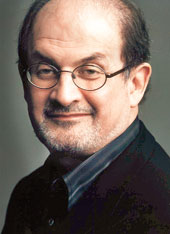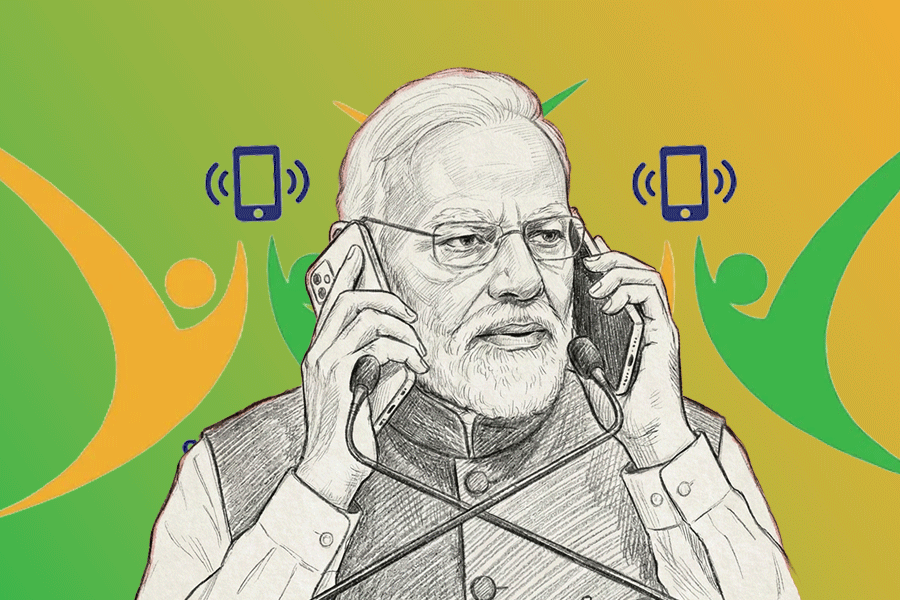 |
“Free speech is life itself”.
— Salman Rushdie
Four weddings and a fatwa — that’s how many would think of Salman Rushdie, rather than his prize-winning novels. The maverick author has said that if his writing career hadn’t been successful, he would have been an actor. He says he realised his penchant for being in front of the camera during his frequent cameo appearances in films (remember Bridget Jones’s Diary?).
Born in Bombay on June 19, 1947, to Kashmiri Muslim parents, Rushdie received his MA from King’s College, Cambridge. He has always identified himself as being very much a member of the diaspora, which is probably the most consistently autobiographical aspect of his work. In 1964, with Indo-Pakistan tensions running high, many were forced to immigrate and Rushdie’s parents moved to Karachi. This choosing of sides and divided loyalties impacted him heavily.
Years before his exile from the public eye, he had presciently said: “I have a fear that it may, at some point, become necessary to make choices among [India, England and America],
and that it will be very painful.”
 |
Midnight’s Children (1981)
One of the finest examples of magic realism, this multi-faceted, multi-layered novel is at once a fairy tale and a political narrative.
The plot: It tells the story of Saleem Sinai, who was born at the precise moment of independence for his country, India. Rushdie uses this to elevate Saleem’s life from the ordinary to the fantastical, and due to the timing of Saleem’s birth, we are told that he was “mysteriously handcuffed to history”. Saleem, who is variously called Snotnose, Stainface, Baldy, Buddha, Piece-of-the-Moon, is born with telepathic powers and a constantly dripping nose.
Through him, we experience the crises, contours and culture of a nation trying to find its identity, even as he finds his. As the story unfolds, we learn that all children born at the time of India’s Independence possess special powers, and their powers are stronger the closer they are born to the midnight moment.
The style: Melancholic at times, dark at others, the novel is always enlightening and often humorous.
t2 says: Yes, the narrative can be a bit overwhelming at first and requires complete concentration. Get through the first 100 pages and you will be richly rewarded with a story about the “chutnification of history” and “the pickling of time”. This is probably the best “starter book” for someone wanting to read Rushdie.
 |
The Satanic Verses (1988)
This book earned its author a death sentence, a $1 million bounty on his head, sparked riots around the world and caused Rushdie to live in hiding for nearly a decade. In 1989, five people died in riots in Pakistan and a stone-throwing mob injured 60 people in India in incidents related to The Satanic Verses. Iran’s Ayatollah Khomeini issued a fatwa against Rushdie. Japan fined anyone who sold the English-language edition and a Japanese translator was stabbed to death for his involvement with it. Venezuela threatened anyone who owned or read the book with 15 months in prison. US booksellers Barnes & Noble and Waldenbooks removed the book from their shelves after receiving death threats. And threats of violence to Rushdie’s publisher, Viking Penguin, forced the company to temporarily close its New York City office. The book also went on to become a finalist for the 1988 Booker Prize and won the Whitbread Prize the same year. The book was banned by India in 1989. It is still banned in India.
The plot: Two Indians, movie star Gibreel Farishta and Saladin Chamcha, (a Bombay expatriate returning from his first visit to his homeland in 15 years) are flying across the English Channel when the jet explodes. The only survivors of the blast, the duo are found on an English beach. There’s just one thing — Gibreel has a halo, while Saladin’s legs are hairier, with hooves instead of feet and horns sprouting from his head. What follows is a marvellous study of good and evil that challenges perceptions with an energetic series of comic allegorical tales.
But why the hoopla? Some said it was a blasphemous treatment of the Islamic faith — throughout the book, Rushdie refers to Prophet Muhammad as Mahound, the medieval name for the Devil. This, coupled with its portrayal of sensitive topics such as the wives of Prophet Muhammad and the omniscience of the Quran, stoked the controversy around the novel.
The style: Controversy aside, it’s a rich and complex metaphorical novel, broad in its exploration of the nature of good and evil and cultural and racial identities. Its parallel narratives and alternating dream and reality sequences are classic Rushdie. Here there are angels and demons who seemingly trade places.
t2 says: Ironical and satirical, this book does address the religious beliefs and practices of Islam, but that’s by no means the only questions posed to the reader in this fantastical tale.
 |
Luka and the Fire of Life (2010)
Rushdie’s latest offering is a tale for the young and the young at heart, and comes 20 years after its predecessor, Haroun and the Sea of Stories. Haroun..., which was written shortly after the fatwa against Rushdie, is said to be a response to it, as well as a gift for his son, Zafar.
The plot: Haroun...’s basic narrative about a boy who enters a magical world to defeat wicked forces is repeated in Luka..., which has been written for Milan, Rushdie’s younger son. In fact, 12-year-old Luka is Haroun’s younger brother.
On a beautiful starry night in the city of Kahani in the land of Alifbay, a terrible thing happens: Luka and Haroun’s father Rashid Khalifa, “a professional storyteller” also known as the Shah of Blah and the Ocean of Notions, inexplicably falls into a sleep so deep that nothing can rouse him. Haroun tells his younger brother, ‘It’s your turn for an adventure,’ and so Luka embarks on a daredevil mission to the World of Magic, to return with the Fire of Life in order to revive his father.
The style: A classic quest fairy tale, it brings to mind the Arabian Nights and the Katha Sarit Sagara. Rushdie delights in referencing popular culture — everything from videogames (Luka worries about how many ‘lives’ he has left) to Angelina Jolie, not to forget the land of Oh-Tee-Tee, “whose denizens, the Otters, are devoted to all forms of excess”.
t2 says: Luka... is a delight, but fails to live up to Haroun..., which by default, is not just a book but a product of the intense political and personal circumstances Rushdie found himself in at the time.
fast facts
 |
| Salman Rushdie with Padma Lakshmi in Calcutta in 2004 |
![]() In 2008, The Times ranked Rushdie 13th on its list of “The 50 greatest British writers since 1945”.
In 2008, The Times ranked Rushdie 13th on its list of “The 50 greatest British writers since 1945”.
![]() In 1990, he publicly apologised to those offended by The Satanic Verses.
In 1990, he publicly apologised to those offended by The Satanic Verses.
![]() Rushdie tied the knot four times. He was married to Clarissa Luard from 1976 to 1987 and fathered a son, Zafar. His second wife was the American novelist Marianne Wiggins; they were married in 1988 and divorced in 1993. His third wife, from 1997 to 2004, was Elizabeth West; they have a son, Milan. In 2004, he married the actress and model Padma Lakshmi. The marriage ended in July 2007, with she dumping him.
Rushdie tied the knot four times. He was married to Clarissa Luard from 1976 to 1987 and fathered a son, Zafar. His second wife was the American novelist Marianne Wiggins; they were married in 1988 and divorced in 1993. His third wife, from 1997 to 2004, was Elizabeth West; they have a son, Milan. In 2004, he married the actress and model Padma Lakshmi. The marriage ended in July 2007, with she dumping him.
![]() His first novel Grimus, a part-science fiction, was generally ignored by the public and literary critics.
His first novel Grimus, a part-science fiction, was generally ignored by the public and literary critics.
![]() Rushdie was knighted for services to literature in the Queen’s birthday honours in 2007.
Rushdie was knighted for services to literature in the Queen’s birthday honours in 2007.










